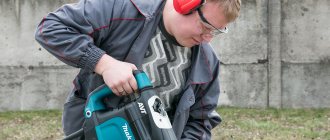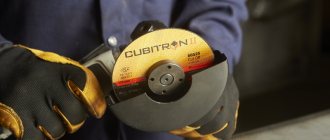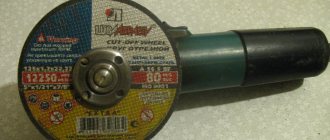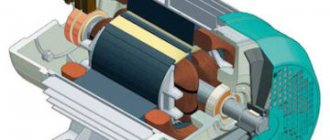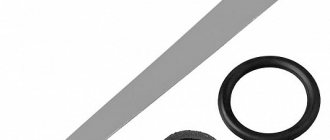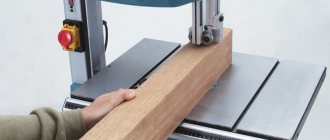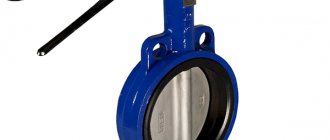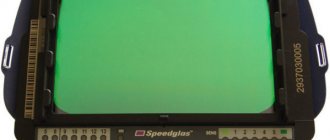Safety glasses for working with an angle grinder belong to personal protective equipment (PPE) for eyes with increased mechanical strength (marking S according to GOST 12.4.253-2013). This is due to the fact that they must protect the operator’s organs of vision not only from sparks and small particles of the material being processed and abrasive, but also from large fragments of metal and stone, as well as parts of the cutting wheel when it is destroyed during operation. The weight of such damaging elements can reach tens of grams, therefore, in accordance with GOST, protective glasses of this category are tested by the impact of a steel ball weighing at least 43 g. When cutting metal with a grinder, the glasses must also act as a light filter, weakening the brightness of the sheaf of sparks to the required limit. And when working with stone, concrete and ceramics, protect your eyes from fine dust. Using an angle grinder without personal eye protection is strictly prohibited, as is reminded by a special icon on the cutting discs and in the passports of the manufacturers of this tool.
Types of safety glasses
GOST 12.4.253—2013 establishes two main design types of safety glasses for working with angle grinders and other types of hand-held power tools: open and closed. In addition, the first type is divided into two subtypes: with and without side protection. Open glasses are designed to work in dust-free conditions, so the space underneath is freely ventilated and they do not fog up. Side protection is designed to prevent particles flying parallel to the face of the angle grinder operator from getting into the eyes. For better visibility while working, this part is usually made of the same material as the front lens (see photo above).
Closed goggles look similar to a diving mask. They completely protect the eyes from dust and aggressive fumes that occur when using an angle grinder on stone and plastics, but without special coatings they are prone to fogging and are less comfortable. Air enters the interior of such glasses through special valves, which must be thoroughly cleaned after prolonged use. On the head of the angle grinder operator, open glasses are held in place by springy arms, which, in accordance with regulations, must be adjusted in length. In addition, some models have a hinged mount for the viewing glass, which allows you to tilt it during operation at a convenient angle. Closed ones are attached to the head using an elastic band or an elastic rim, the width of which, in accordance with GOST, must be at least 10 mm. In the photo below: on the left are open glasses for an angle grinder with side protection, on the right are closed ones with valves.
Previously, in personal eye protection, tempered glass, including toughened glass (in the form of triplex), was widely used as a material for viewing lenses. Nowadays it is used much less frequently, and the main materials are now impact-resistant plastics. They are 40% lighter than glass and at the same time have almost the same optical properties. When working with grinders, it is recommended to use eye protection with polycarbonate lenses. This material has the highest impact and thermal resistance among optical plastics. Its main disadvantage is clouding during prolonged exposure to ultraviolet radiation and a tendency to form scratches during operation under the influence of flying metal and abrasive grains.
The first problem is solved by applying a coating to the surface of the lenses that protects them from exposure to UV radiation, or by adding special stabilizing additives to the polycarbonate at the production stage. To solve the second problem, the outer surface of the viewing glass is covered with a protective layer of increased hardness. It is better not to use safety glasses with other plastics, which include the well-known plexiglass (plexiglass, acrylic resin) and cellulose acetate (CA plastic), when working with an angle grinder, since they have much less impact resistance. In the photo below, a fragment of an angle grinder's cutting disc is stuck in a polycarbonate lens.
Don't look at the bright light!
Eye protection during plasma cutting is a question that interests many. Let's look at the problem in more detail. When cutting, a plasma arc, like any electric arc, emits a wide range of electromagnetic radiation, which goes all the way: from infrared light (passing through the visible spectrum) to its ultraviolet range. The electric current during plasma cutting can be very intense, ranging from 100 to 800 Amperes. It goes without saying that looking at the arc can easily cause eye damage. If a worker's retina is exposed to bright light for a long time, the consequences may be more serious. How to avoid this?
Recommended eye protection for plasma cutting
There are several important, good sources that have standards and recommendations that any good welder should know. These include OSHA and ANSI standards, as well as OST 5.9823-80 “Electric welding works. Safety requirements".
Let's consider foreign standards. OSHA is the US Federal Occupational Safety and Health Agency. Their fact sheet, “Protecting Eyes from Radiant Energy During Welding and Cutting in Shipbuilding Operations,” has guidelines for welder eye protection citing data from ANSI (American National Standards Institute). The eclipse degree numbers refer to safety glasses or welding helmets. The higher the number, the darker the glass.
ANSI and the American Welding Society (AWS) have published an even more detailed table, “Safety in Welding, Cutting, and Related Processes (ANSI Z49.1: 2005).”
In both cases, the guidelines suggest a rule of thumb: “Start with the shade that is darkest to show the weld area. Then we move to a lighter shade that gives enough representation of the welding area without going below the minimum.”
ANSI recommendations for SMAW, GMAW and FCAW welding are in the shade range with shade number 10 - 14. How does this apply to a welding operation? When welding, you basically stand and look at the welding area through your helmet as usual, and you can manually operate the welding torch, which is just a few centimeters from your face.
But the operation of a CNC machine is slightly different:
- the operator is much more likely to be further away from the arc;
- the welder must move around, so he must be able to clearly see his surroundings (this is relatively dangerous in a welding helmet);
- the operator must have visual ability to control the machine while the arc is on;
- The welding arc moves, so the operator will not always be able to see in its direction.
Which is better: glasses or a mask?
In addition to glasses, when working with an angle grinder, protective masks (transparent face shields) are used, which protect not only the eyes, but the entire area of the face to the chin and ears. This type of personal vision protection has a number of undeniable advantages, among which the main thing is complete protection of the face from fast-flying particles. This is especially important when working with an angle grinder in confined spaces, when particles of metal and abrasive ricochet and hit your face from different directions. Another positive feature of face shields is the almost complete absence of optical distortion, which is inherent to one degree or another in all safety glasses. Therefore, when working with an angle grinder for a long time, many people prefer this type of protection. The disadvantages, or rather limitations, of using face shields include the free penetration of dust and fumes under them. Therefore, they cannot be used when using a grinder to process stone, concrete or ceramics. In addition, face shields are much more massive and heavier than glasses and, with the same quality of optical material, are more expensive. The debate about which of these AIS is better and more convenient does not make sense, since each of them is used for certain types of work and specific situations. Moreover, in some cases, angle grinder operators use them together, and a number of manufacturers even produce special face shields that are attached to closed glasses (see photo below).
Deca WM 30 LCD
Manufacturer mask from Italy. Weight – 430 grams, works from two types of energy sources. It is resistant to temperatures up to 55 °C, has a modern design and is made of high-quality plastic. It differs from others in its high-quality light filter:
Welding helmet Deca WM 30 LCD
- optics 1/1/1;
- multilayer;
- liquid crystal filter;
- electron-optical system;
- microprocessor board.
Dimming range from 9 to 13, will work in 1/25000th of a second. The plastic is fireproof, you can use the mask even for argon-arc welding. Among the disadvantages is the stepwise setting, which has only five positions. The kit does not include a replacement battery.
What to look for when choosing
When choosing safety glasses designed for working with an angle grinder, you should first of all understand that there are no universal eye protection products and that each of them has its own area of application. Open models with side protection are suitable for working with metal in free space for movement, and when cutting mineral materials and concrete, only closed versions should be used. When working with an angle grinder for a long time, the optical parameters of the lens are important, on which the level of distortion and, accordingly, eye fatigue depend. In such cases, you should use lenses only of the first optical class and from trusted manufacturers. Processing with a grinder is accompanied by the active release of solid fast-flying particles, so it is necessary to use polycarbonate front glass with mechanical strength of classes A and S. And to avoid fogging of the lenses during work, you can purchase glasses with a special coating to protect against condensation. All these parameters are part of the marking code, which is usually printed on the lower right side of the product.
3M Speedglas 100V
Swedish mask, which is suitable for any type of welding: TIG, MMA, SWAM, PAW, can be used when grinding and cutting metal. The light filter operates in several modes depending on the lighting around.
You can replace the power source and the filter itself. It has five levels of dimming in three sensitivity modes. When the charge level decreases, it notifies the welder.
Review of the best models and manufacturers of glasses and masks
There are several dozen brands on the Russian market that offer personal protective equipment for the eyes, including glasses for working with angle grinders. But only some of them are directly manufacturers of personal protective equipment, and the rest are international and Russian brands owned by manufacturers and sellers of power tools, gardening and power equipment. In the first group, the most famous are the Russian JSC Suksun Optical-Mechanical Plant (trademark ROSOMZ) and two very well-known international companies: Uvex and 3M. In user reviews and reviews of safety glasses designed for working with angle grinders, models of power tool brands such as Zubr, Sturm, Styer and Fit, as well as ROSOMZ products, are noted among the lower and middle price ranges. Closed models with indirect ventilation ROSOMZ ZN11 Panorama, Zubr 110230, Sturm 8050-05-02 and Stayer 2-110291 are popular among grinder users. In the upper price range of personal eye protection, the undisputed leadership belongs to 3M and Uvex, and the latter’s products are also produced under such well-known brands as Makita, Hilti, Husqvarna and others. Here, in terms of price-quality ratio, owners of grinders distinguish the closed models 3M 2890, Uvex Ultravision 9301714, as well as the Russian ROSOMZ Surgut.
DECA WM 23
Durable and flexible plastic, mechanically resistant. The filter works at 1/10000, but there are no dimming settings. There is only one indicator - 11 DIN, and therefore the mask is inferior to competitors with adjustment in the ranges of 5-13 and others. Polyamide helmet. Among the disadvantages are that the kit does not include replaceable batteries, and the dimming is not adjustable.
Care and storage rules
If possible, safety glasses used when working with an angle grinder should be cleaned of dirt after the end of each work shift. Cleaning is carried out in two stages: first, the lenses are washed with running water, and then the entire product is wiped dry with a soft fiber cloth. You need to be especially careful with coated lenses, as their thickness is usually only a few microns. When cleaning, do not use chemical solvents, as well as water and solutions with temperatures above 60 ºC. It is necessary to store glasses for working with an angle grinder in a protective case, away from sources of heat and active chemicals.
You can often find glasses without markings, which sellers recommend for working with an angle grinder, citing positive experience with their use. How can we relate to these statements and how safe are such PPE? Please write what you think about this in the comments.
Will regular anti-dust masks protect against welding aerosols?
Dust respirators provide respiratory protection from various types of dust, dusts, powdered fertilizers, acids and alkalis. These types of PPE do not perform the full range of protective functions for the welder . Therefore, you should not choose them as a replacement for special respirators. This may result in injury or illness. Anti-dust half masks are suitable for construction work, for example when cutting concrete or sand-lime brick.
Where can I buy
Manufacturers, authorized representatives, suppliers and specialty stores offer a wide range of respiratory protection devices. American factories occupy the leading position in this segment. In addition, performers are provided with a large selection of products from Russian enterprises.
You can familiarize yourself with the proposed list of respirators and other products for welding in the “Where to buy electrodes” section. Trading companies sell goods at retail and wholesale. Organizations actively cooperate with individuals, individual entrepreneurs and enterprises of various profiles.
